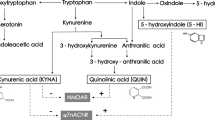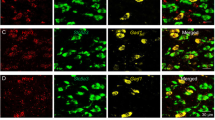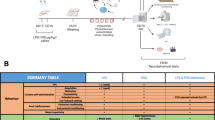Abstract
Some of the major concerns related to methamphetamine (METH) abuse are the neuronal damage inflicted at dopamine (DA) nerve terminals and the cognitive deficits observed in human METH abusers. We have shown that a high dose of METH selectively depleted dopaminergic markers in striatum, frontal cortex and amygdala of Swiss Webster mice, and impaired learned place preference. In this study, we investigated whether deficits in consolidation of place learning, as a consequence of METH neurotoxicity, underlie the underperformance of cocaine conditioned place preference (CPP). Administration of METH (5 mg/kg × 3) to Swiss Webster mice decreased striatal tyrosine hydroxylase (TH) immunoreactive neurons and significantly increased glial fibrillary acidic protein (GFAP) expression, confirming the neurotoxic potential of METH in mice. This treatment significantly attenuated the establishment of cocaine (15 mg/kg) CPP compared to control. To investigate whether manipulation of the consolidation phase improves learned place preference, mice were trained by cocaine and received daily post-training injections of DA receptor agonists or N-acetylcysteine (NAC). As memory consolidation occurs shortly after training, drugs were administered either immediately or 2 h post-training. Immediate post-training administration of the D1 DA receptor agonist SKF38393 (5, 10, and 20 mg/kg) or the D2 DA receptor agonist quinpirole (0.25, 0.5, and 1.0 mg/kg) did not improve the establishment of CPP following METH neurotoxicity. However, immediate but not delayed NAC administration (50 and 100 mg/kg) enhanced cocaine CPP following METH neurotoxicity and had no effect on control CPP. The levels of the reduced form of glutathione (GSH) in striatum, amygdala, hippocampus and frontal cortex were significantly lower in METH-treated mice compared to control during the period of CPP training. Acute and repeated administration of NAC to METH-treated mice restored the decreased brain GSH but had no effect on controls. Results suggest that METH-induced dopaminergic neurotoxicity is associated with impairment of consolidation of learned place preference, and that this impairment is improved by immediate post-training administration of the glutathione precursor NAC and not by D1 or D2 DA receptor agonists. Restoration of brain glutathione levels immediately post-training may facilitate the consolidation process.
Similar content being viewed by others
Log in or create a free account to read this content
Gain free access to this article, as well as selected content from this journal and more on nature.com
or
References
Achat-Mendes C, Ali SF, Itzhak Y (2005). Differential effects of amphetamines-induced neurotoxicity on appetitive and aversive Pavlovian conditioning in mice. Neuropsychopharmacology 30: 1129–1137.
Acikgoz O, Gonenc S, Gezer S, Kayatekin BM, Uysal N, Semin I et al (2001). Methamphetamine causes depletion of glutathione and an increase in oxidized glutathione in the rat striatum and prefrontal cortex. Neurotox Res 3: 277–280.
Axt KJ, Molliver ME (1991). Immunocytochemical evidence for methamphetamine-induced serotonergic axon loss in the rat brain. Synapse 9: 302–313.
Baker DA, McFarland K, Lake RW, Shen H, Tang XC, Toda S et al (2003). Neuroadaptations in cystine-glutamate exchange underlie cocaine relapse. Nat Neurosci 6: 743–749.
Banaclocha MM (2001). Therapeutic potential of N-acetylcysteine in age-related mitochondrial neurodegenerative diseases. Med Hypotheses 56: 472–477.
Battaglia G, Fornai F, Busceti CL, Aloisi G, Cerrito F, De Blasi A et al (2002). Selective blockade of mGlu5 metabotropic glutamate receptors is protective against methamphetamine neurotoxicity. J Neurosci 22: 2135–2141.
Cadet JL, Jayanthi S, Deng X (2003). Speed kills: cellular and molecular bases of methamphetamine-induced nerve terminal degeneration and neuronal apoptosis. FASEB J 17: 1775–1788.
Chang L, Ernst T, Speck O, Patel H, DeSilva M, Leonido-Yee M et al (2002). Perfusion MRI and computerized cognitive test abnormalities in abstinent methamphetamine users. Psychiatry Res 114: 65–79.
Costanzi M, Battaglia M, Rossi-Arnaud C, Cestari V, Castellano C (2004). Effects of anandamide and morphine combinations on memory consolidation in cd1 mice: involvement of dopaminergic mechanisms. Neurobiol Learn Memory 81: 144–149.
Cruz R, Almaguer MW, Bergado RJA (2003). Glutathione in cognitive function and neurodegeneration. Rev Neurol 36: 877–886.
Dalley JW, Laane K, Theobald DE, Armstrong HC, Corlett PR, Chudasama Y et al (2005). Time-limited modulation of appetitive Pavlovian memory by D1 and NMDA receptors in the nucleus accumbens. Proc Natl Acad Sci USA 102: 6189–6194.
Di Chiara G (2002). Nucleus accumbens shell and core dopamine: differential role in behavior and addiction. Behav Brain Res 137: 75–114.
Dringen R (2000). Metabolism and functions of glutathione in brain. Prog Neurobiol 62: 649–671.
Farr SA, Poon HF, Dogrukol-Ak D, Drake J, Banks WA, Eyerman E et al (2003). The antioxidants alpha-lipoic acid and N-acetylcysteine reverse memory impairment and brain oxidative stress in aged SAMP8 mice. J Neurochem 84: 1173–1183.
Flora G, Lee YW, Nath A, Maragos W, Hennig B, Toborek M (2002). Methamphetamine-induced TNF-alpha gene expression and activation of AP-1 in discrete regions of mouse brain. Neuromolecular Med 2: 71–85.
Gibb JW, Johnson M, Hanson GR (1990). Neurochemical basis of neurotoxicity. Neurotoxicol 11: 317–322.
Greba Q, Gifkins A, Kokkinidis L (2001). Inhibition of amygdaloid dopamine D2 receptors impairs emotional learning with fear-potentiated startle. Brain Res 899: 218–226.
Han J, Cheng FC, Yang Z, Dryhurst G (1999). Inhibitors of mitochondrial respiration, iron (II), and hydroxyl radical evoke release and extracellular hydrolysis of glutathione in rat striatum and substantia nigra: potential implications to Parkinson's disease. J Neurochem 73: 1683–1695.
Harold C, Wallace T, Friedman R, Gudelsky G, Yamamoto B (2000). Methamphetamine selectively alters brain glutathione. Eur J Pharmacol 400: 99–102.
Hernandez PJ, Andrzejewski ME, Sadeghian K, Panksepp JB, Kelley AE (2005). AMPA/kainite, NMDA, and dopamine D1 receptor function in the nucleus accumbens core: a context-limited role in the encoding and consolidation of instrumental memory. Learn Memory 12: 285–295.
Hirrlinger J, Schulz JB, Dringen R (2002). Effects of dopamine on the glutathione metabolism of cultured astroglial cells: implications for Parkinson's disease. J Neurochem 82: 458–467.
Hoffman DC, Beninger JR (1988). Selective D1 and D2 dopamine agonists produce opposing effects in place conditioning but not in conditioned taste aversion learning. Pharmacol Biochem Behav 31: 1–8.
Itzhak Y, Achat-Mendes C (2004). Methamphetamine and MDMA (ecstasy) neurotoxicity: ‘of mice and men’. IUBMB Life 56: 249–255.
Itzhak Y, Ali SF (2006). Role of nitrergic system in behavioral and neurotoxic effects of amphetamine analogs. Pharmacol Ther 109: 246–262.
Itzhak Y, Martin JL, Ali SF (2002). Methamphetamine-induced dopaminergic neurotoxicity in mice: long-lasting sensitization to the locomotor stimulation and desensitization to the rewarding effects of methamphetamine. Prog Neuropsychopharmacol Biol Psychiatry 26: 1177–1183.
Itzhak Y, Martin J, Ali SF, Norenberg MD (1997). Depletion of striatal dopamine transporter does not affect psychostimulant-induced locomotor activity. Neuro Report 8: 3245–3249.
Kannan R, Kuhlenkamp JF, Jeandidier E, Trinh H, Ookhtens M, Kaplowitz N (1990). Evidence for carrier-mediated transport of glutathione across the blood-brain barrier in the rat. J Clin Investig 85: 2009–2013.
Koch M, Schmid A, Schnitzler HU (2000). Role of nucleus accumbens dopamine D1 and D2 receptors in instrumental Pavlovian paradigm of conditioned reward. Psychopharmacol 152: 67–73.
LaLumiere RT, Nawar EM, McGaugh JL (2005). Modulation of memory consolidation by the basolateral amygdala or nucleus accumbens shell requires concurrent dopamine receptor activation in both brain regions. Learn Memory 12: 296–301.
Lee YW, Hennig B, Yao J, Toborek M (2001). Methamphetamine induces AP-1 and NF-kappaB binding and transactivation in human brain endothelial cells. J Neurosci Res 66: 583–591.
Lyles J, Cadet JL (2003). Methylenedioxymethamphetamine (MDMA, Ecstasy) neurotoxicity: cellular and molecular mechanisms. Brain Res Rev 42: 155–168.
Mandel S, Grunblatt E, Riederer P, Gerlach M, Levites Y, Youdim MB (2003). Neuroprotective strategies in Parkinson's disease: an update on progress. CNS Drugs 17: 729–762.
Mark KA, Soghomonian JJ, Yamamoto BK (2004). High-dose methamphetamine acutely activates the striatonigral pathway to increase striatal glutamate and mediate long-term dopamine toxicity. J Neurosci 24: 11449–11456.
Martinez M, Hernandez AI, Martinez N (2000). N-Acetylcysteine delays age-associated memory impairment in mice: role in synaptic mitochondria. Brain Res 855: 100–106.
McCann UD, Wong DF, Yokoi F, Villemagne V, Dannals RF, Ricaurte GA (1998). Reduced striatal dopamine transporter density in abstinent methamphetamine and methcathinone users: evidence from positron emission tomography studies with [11C]WIN-35,428. J Neurosci 18: 8417–8422.
Mele A, Castellano C, Felici A, Cabib S, Caccia S, Oliverio A (1996). Dopamine-N-methyl-D-aspartate interactions in the modulation of locomotor activity and memory consolidation in mice. Eur J Pharmacol 308: 1–12.
Mirecki A, Fitzmaurice P, Ang L, Kalasinsky KS, Peretti FJ, Aiken SS et al (2004). Brain antioxidant systems in human methamphetamine users. J Neurochem 89: 1396–1408.
Moszczynska A, Turenne S, Kish SJ (1998). Rat striatal levels of the antioxidant glutathione are decreased following binge administration of methamphetamine. Neurosci Lett 255: 49–52.
Nader K, LeDoux JE (1999). Inhibition of the mesoamygdala dopaminergic pathway impairs the retrieval of conditioned fear associations. Behav Neurosci 113: 891–901.
O'Callaghan JP, Miller DB (1994). Neurotoxicity profiles of substituted amphetamines in the C57BL/6J mouse. J Pharmacol Exp Ther 270: 741–751.
Offen D, Ziv I, Sternin H, Melamed E, Hochman A (1996). Prevention of dopamine-induced cell death by thiol antioxidants: possible implications for treatment of Parkinson's disease. Exp Neurol 141: 32–39.
Oja SS, Janaky R, Varga V, Saransaari P (2000). Modulation of glutamate receptor functions by glutathione. Neurochem Intl 37: 299–306.
Parkinson JA, Dalley JW, Cardinal RN, Bamford A, Fehnert B, Lachenal G et al (2002). Nucleus accumbens dopamine depletion impairs both acquisi-tion and performance of appetitive Pavlovian approach behaviour: implications for meso-accumbens dopamine function. Behav Brain Res 137: 149–163.
Pezze MA, Feldon J (2004). Mesolimbic dopaminergic pathways in fear conditioning. Prog Neurobiol 74: 301–320.
Phillips GD, Setzu E, Hitchcott PK (2003). Facilitation of appetitive Pavlovian conditioning by d-amphetamine in the shell, but not the core, of the nucleus accumbens. Behav Neurosci 117: 675–684.
Ricaurte GA, Guillery RW, Seiden LS, Schuster CR, Moore RY (1982). Dopamine nerve terminal degeneration produced by high doses of methylamphetamine in the rat brain. Brain Res 235: 93–103.
Seiden LS, Sabol KE (1996). Methamphetamine and methylenedioxymethamphetamine neurotoxicity: possible mechanisms of cell destruction. NIDA Res Monogr 163: 251–276.
Setlow B, McGaugh JL (1998). Sulpiride infused into the nucleus accumbens posttraining impairs memory of spatial water maze training. Behav Neurosci 112: 603–610.
Setlow B, McGaugh JL (2000). D2 dopamine receptor blockade immediately post-training enhances retention in hidden and visible platform versions of the water maze. Learn Memory 7: 187–191.
Sheng P, Cerruti C, Cadet JL (1994). Methamphetamine (METH) causes reactive gliosis in vitro: attenuation by the ADP-ribosylation (ADPR) inhibitor, benzamide. Life Sci 55: PL51–PL54.
Smith-Roe SL, Kelley AE (2000). Coincident activation of NMDA and dopamine D1 receptors within the nucleus accumbens core is required for appetitive instrumental learning. J Neurosci 20: 7737–7742.
Sora I, Wichems C, takahashi N, Li XF, Zeng Z, Revay R et al (1998). Cocaine reward models: conditioned place preference can be established in dopamine- and in serotonin-transporter knockout mice. Proc Natl Acad Sci USA 95: 7699–7704.
Stephans SE, Yamamoto BK (1994). Methamphetamine-induced neurotoxicity: roles for glutamate and dopamine efflux. Synapse 17: 203–209.
Varga V, Jenei Z, Janaky R, Saransaari P, Oja SS (1997). Glutathione is an endogenous ligand of rat brain N-methyl-D-aspartate (NMDA) and 2-amino-3-hydroxyl-5-methyl-4-isoxazolepropionate (AMPA) receptors. Neurochem Res 22: 1165–1171.
Villemagne V, Yuan J, Wong DF, Dannals RF, Hatzidimitriou G, Mathews WB et al (1998). Brain dopamine neurotoxicity in baboons treated with doses of methamphetamine comparable to those recreationally abused by humans: evidence from [11C]WIN-35,428 position emission tomography studies and direct in vitro determinations. J Neurosci 18: 419–427.
Volkow ND, Chang L, Wang GJ, Fowler JS, Franceschi D, Sedler M et al (2001a). Loss of dopamine transporters in methamphetamine abusers recovers with protracted abstinence. J Neurosci 21: 9414–9418.
Volkow ND, Chang L, Wang GJ, Fowler JS, Leonido-Yee M, Franceschi D et al (2001b). Association of dopamine transporter reduction with psychomotor impairment in methamphetamine abusers. Am J Psychiatry 158: 377–382.
Warr O, Takahashi M, Attwell D (1999). Modulation of extracellular glutamate concentration in rat brain slices by cystine-glutamate exchange. J Physiol 514: 783–793.
Weber GF (1999). Final common pathways in neurodegenerative diseases: regulatory role of the glutathione cycle. Neurosci Biobehav Rev 23: 1079–1086.
White NM, Carr GD (1985). The conditioned place preference is affected by two independent reinforcement processes. Pharmacol Biochem Behav 23: 37–42.
White NM, Packard MG, Hiroi N (1991). Place conditioning with dopamine D1 and D2 agonists injected peripherally or into nucleus accumbens. Psychopharmacol 103: 271–276.
Acknowledgements
This work was supported by RO1DA012867 and R01 DA019107 from the National Institute on Drug Abuse, National Institutes of Health. Cindy Achat-Mendes was a Lois Pope LIFE fellow. The authors thank Erica Givens for excellent technical assistance.
Author information
Authors and Affiliations
Corresponding author
Rights and permissions
About this article
Cite this article
Achat-Mendes, C., Anderson, K. & Itzhak, Y. Impairment in Consolidation of Learned Place Preference Following Dopaminergic Neurotoxicity in Mice is Ameliorated by N-acetylcysteine but not D1 and D2 Dopamine Receptor Agonists. Neuropsychopharmacol 32, 531–541 (2007). https://doi.org/10.1038/sj.npp.1301119
Received:
Revised:
Accepted:
Published:
Issue date:
DOI: https://doi.org/10.1038/sj.npp.1301119
Keywords
This article is cited by
-
Protective action of Grewia asiatica (phalsa) berries against scopolamine-induced deficit in learning and memory using behavior paradigms in rats
Advances in Traditional Medicine (2020)
-
Flood-conditioned place aversion as a novel non-pharmacological aversive learning procedure in mice
Scientific Reports (2018)
-
The toxic influence of dibromoacetic acid on the hippocampus and pre-frontal cortex of rat: involvement of neuroinflammation response and oxidative stress
Metabolic Brain Disease (2017)
-
Effect of an Inhibitor of Sphingomyelinases, N-Acetylcysteine, on Cognitive Functions in Old Rats
Neurophysiology (2014)
-
N-acetylcysteine protects against cadmium-induced germ cell apoptosis by inhibiting endoplasmic reticulum stress in testes
Asian Journal of Andrology (2013)



